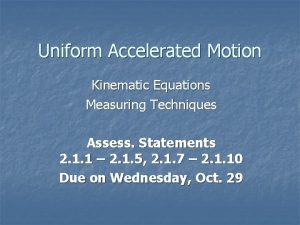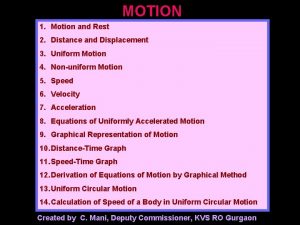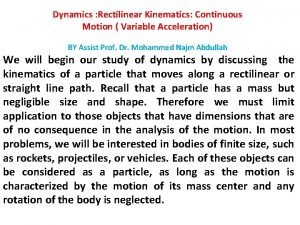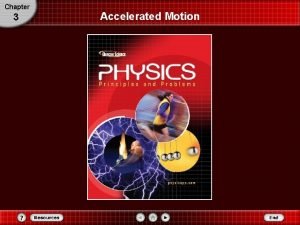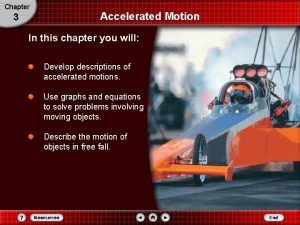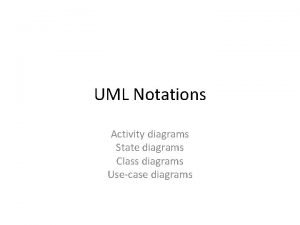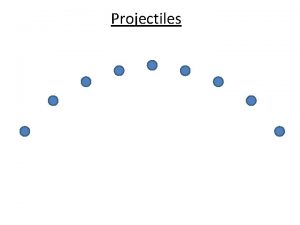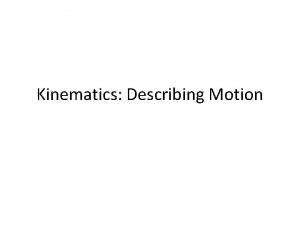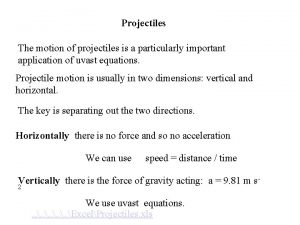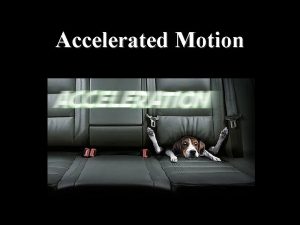Uniformly Accelerated Motion Formulas and Projectiles New notations










- Slides: 10

Uniformly Accelerated Motion Formulas and Projectiles New notations for AP Physics

The Oldies Remember that these formulas are ONLY GOOD for objects under UNIFORM (Constant) ACCELERATION. These are still good equations, but remember now we may have problems with non -uniform acceleration so they are not our only option. We are going to change the notation to more closely reflect a University Physics course for engineering students, but the equations are the same!

Displacement Many textbooks use the letter “s” to represent displacement instead of “d” as we did in Physics 1. Others prefer to use letters that more accurately represent the position along an axis displacement such as “x”, “y” or “z”. We will be using these now…at least most of the time. Remember that displacement is a change in position. So now… Where x, y, z are the final positions along those axes, and x 0, y 0, z 0 are the initial positions along those axes.

Velocity For final velocity, we will just use “v”. Remember this is instantaneous velocity at any given time “t”, so… For initial velocity, we will use “v 0”. The “ 0” subscript refers to time “t=0” which would be the initial value.

Acceleration must be constant for these equations to valid. Good news!! We will not change the notation for acceleration…we get to keep “a”!

Time is time! We will not change time. We get to keep the good ole “t” for time. Time is the interval over which the motion of interest takes place.

New formulas for Projectiles horizontal or “x” – direction vertical or “y” – direction Remember that for projectiles, the horizontal and vertical motions must be separated analyzed independently. Remember that “ax” is zero and “ay” is acceleration due to gravity “g”. CAUTION: The equations in this form assume “up” is “positive” and “down” is “negative”.

Projectiles that start and end at the same height Almost every projectile problem can be solved by starting with the displacement equation to solve for time. In this case… vo θ Since “y” and “y 0” are both the same, vertical displacement y-y 0 = 0. Now solve for time, this will be the time for the entire flight. Remember , if you want to find maximum height you will only use half the time. If you want to find range, use the total time.

Projectiles that land higher than they start vo y θ x Vertical displacement y-y 0 = y. Now solve for time, this will be the time for the entire flight. Then you can use that time to find the horizontal distance at which it was at that height.

Projectiles that land lower than they start. vo Vertical displacement is “-y” Now solve for time, this will be the time for the entire flight. Then you can use that time to find the horizontal distance at which it was at that height. θ -y x
 Uniform acceleration formulas
Uniform acceleration formulas Kinematic equations for uniformly accelerated motion
Kinematic equations for uniformly accelerated motion Uniform rectilinear motion
Uniform rectilinear motion Uniformly accelerated motion
Uniformly accelerated motion Equation of motion graphically
Equation of motion graphically Rectilinear kinematics continuous motion
Rectilinear kinematics continuous motion Standard notations and common functions
Standard notations and common functions Chapter 3 accelerated motion answers
Chapter 3 accelerated motion answers Chapter 3 accelerated motion answers
Chapter 3 accelerated motion answers Activity diagram
Activity diagram Collaboration diagram uml
Collaboration diagram uml

